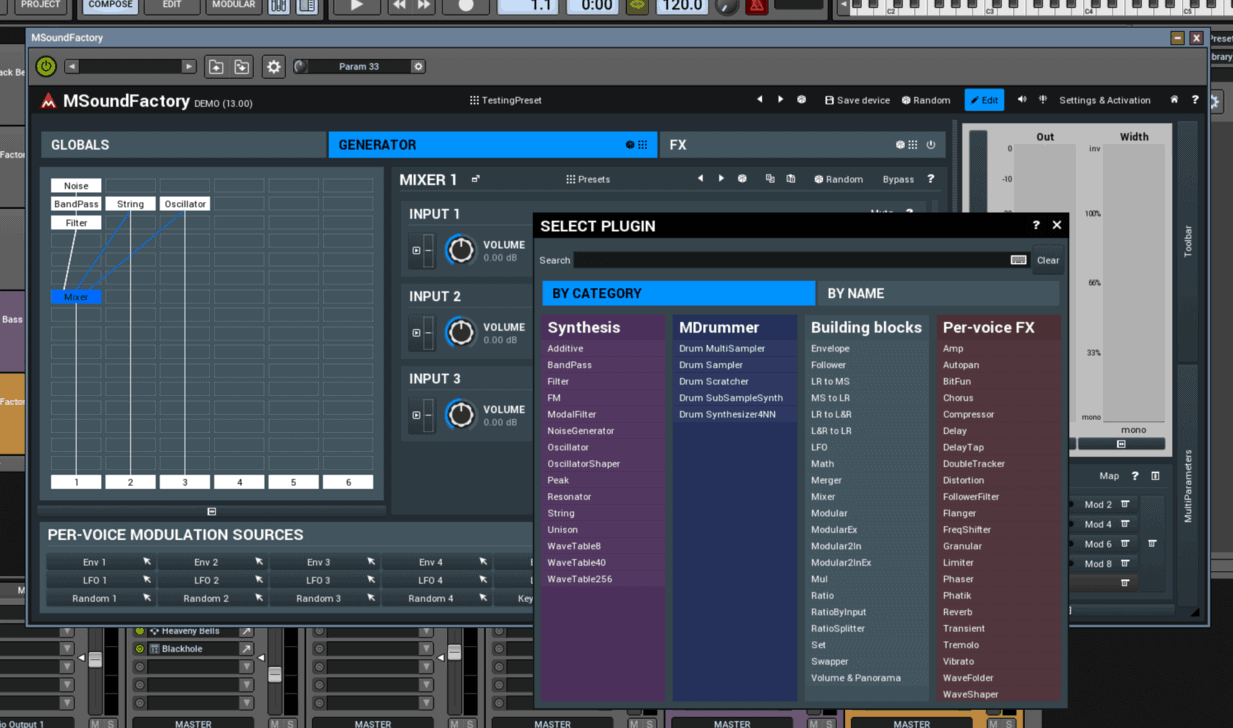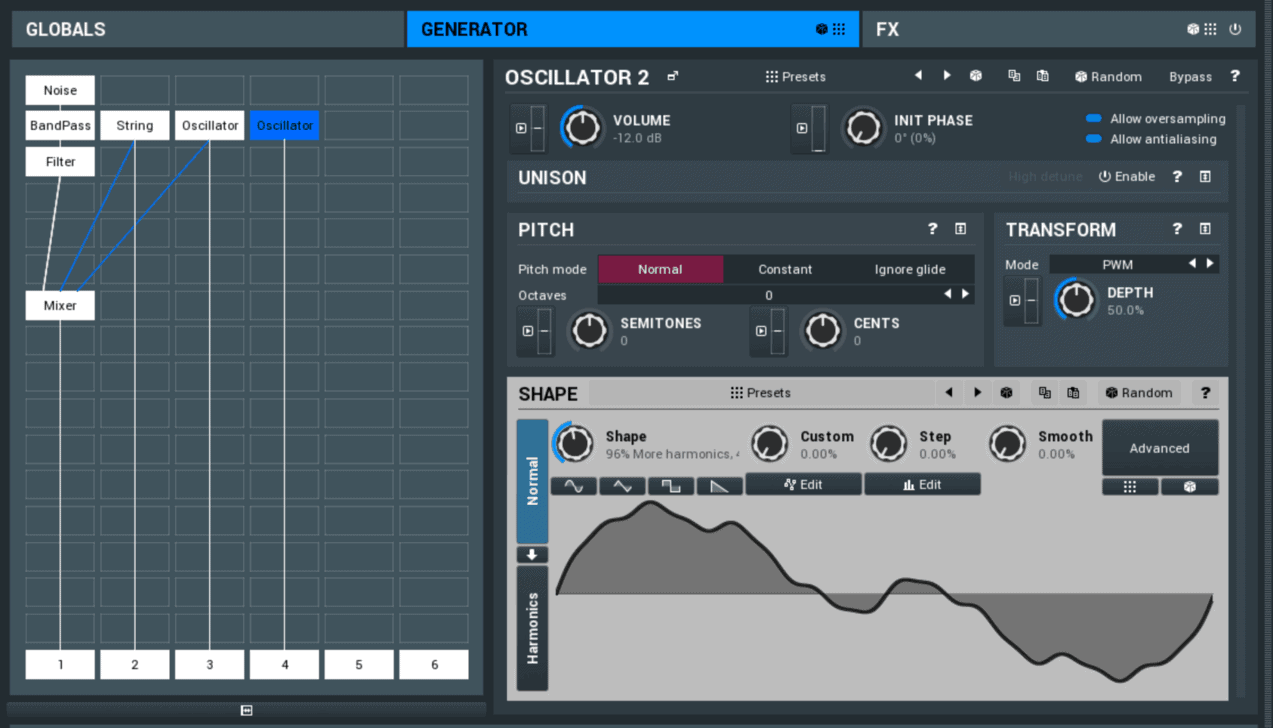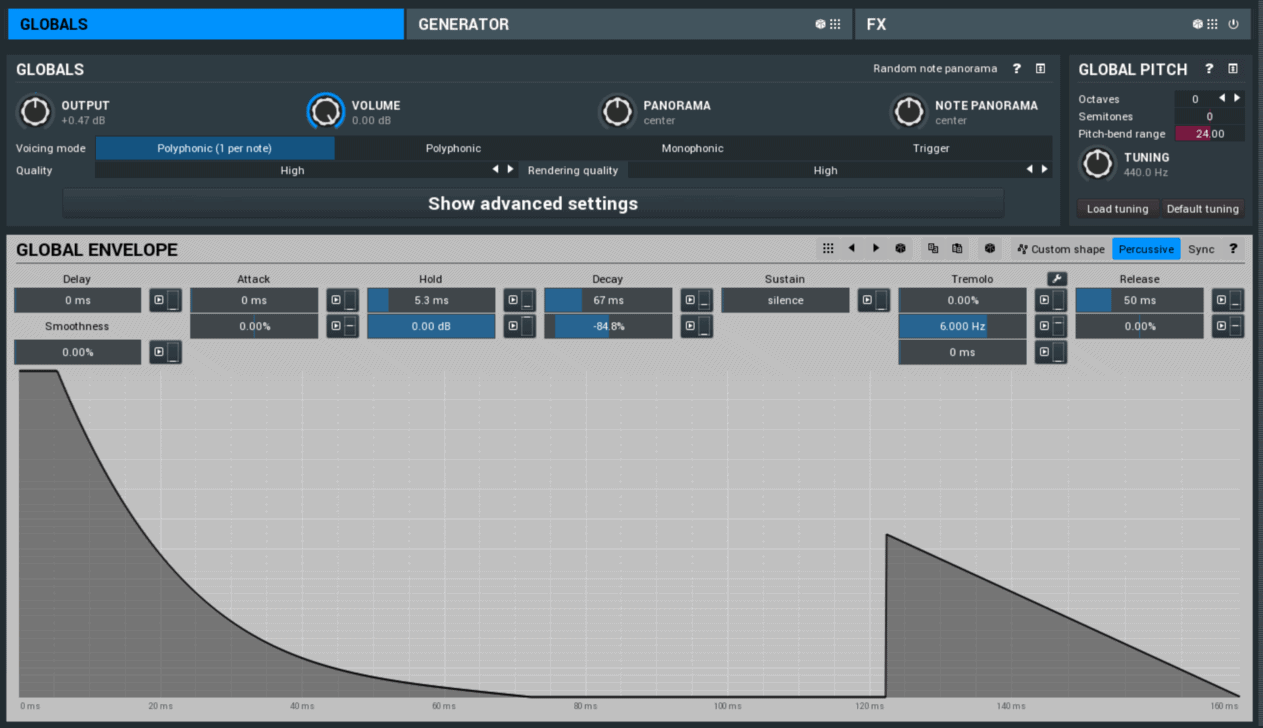A few weeks ago, Melda Production pre-released a brand new and extremely capable super synth called MSoundFactory. While the regular price is 299 EUR, the public beta is being introduced at 99 EUR only, making it of interest to the BPB audience.
Therefore, even though it’s not yet fully polished for an official release, BPB is proud to publish the very first review of this modular beast. It is certainly one of the most powerful modular synthesizer frameworks on the market, available in VST, VST3, AU, and AAX plugin formats for compatible digital audio workstations on PC and Mac.
On a related note, MeldaProduction’s excellent MMultiAnalyzer plugin is now 70% OFF at VSTBuzz (only $19 instead of the regular $68 price tag).
Introduction
There are developers, and then there are developers. And then there is MeldaProduction. Under the lead of Vojtech Meluzin, the Czech company has produced a fantastic array of products, with well over a hundred excellent-sounding and often impressively powerful VST instruments and effects released to date. Most of the plugins are unique in their design approach, almost forcing the user to think like MeldaProduction to unleash their full capabilities. The bright side is that as soon as the user has started to understand and appreciate this approach, it is much easier to use the company’s other products.
See also: Download FREE MConvolutionEZ Convolution Reverb VST/AU PluginMeldaProduction has received quite a lot of unwarranted bashing as well as some warranted criticism over the years for the product line’s user interfaces. Fortunately, the products’ GUIs have been improved drastically as of lately. Since all of their products share the same kernel (programming platform), every product – including old ones – gets its user interface refined and features updated during a version update. The lack of individual product version numbering makes sense as each purchase of a MeldaProduction product includes lifelong updates (!). Instead of paid upgrade paths for the company’s products, every product receives continuous free updates to its GUI and platform-spanning bells, whistles, and nifty features. The new kernel version, released just a few weeks ago, is thirteen. In this case, considering the beta release of the long-awaited MSoundFactory, thirteen might prove to be your lucky number.
Module Mania
Being released as a full-featured modular super synth, featuring all sorts of oscillators, FM, sampling, granular synthesis, physical modeling, wavetables, the MDrummer drum machine, etc., and providing too many stock and unique effects to mention, MSoundFactory seemingly comes out of nowhere. However, in addition to some new sound generating modules, MSoundFactory is the compilation of just about all existing MeldaProduction products, thus forming one of the market’s most potent synthesizers from day one (and remember that at the time of this writing, we’re not even at day one yet). In other words, well-known MeldaProduction plugins such as MMorph and MTurboReverb are included as part of the package, though they obviously cannot be used outside the synth.
Something that struck me when playing around with MSoundFactory was that having all these modules within easy reach allowed me to demo all the MeldaProduction synths and effects which I don’t currently use. These are both highly unusual and creative tools and plugins for more mundane tasks (for example, to my surprise, I became highly impressed with the sounds of the MFilter and MRotary plugins). I’m not sure if using MSoundFactory as a demoing environment was part of the plan, but it certainly should heighten the interest in MeldaProduction’s other products.
Digging Deeper
So how does MSoundFactory make use of all the modular goodies mentioned above? The user is in total control of the synth’s architecture and has the freedom to add sound generators and effects to their heart’s content, route and mix these sources, and then finally add all sorts of modulation and meta-parameters. There aren’t that many fully modular synths on the market. Two low-cost and exciting options are the MUX framework by MuTools and the Fathom synth by Seaweed Audio. Despite the low price tag (both often under a hundred EUR), these are highly capable as well. We will look into MUX and Fathom when their new versions are released.

A typical first-time user of MSoundFactory would probably start by browsing through some of the well-sounding presets, and then press the Edit key to find out what’s going on under the hood. This is where the main work area of MSoundFactory is revealed. The logic is super clear; in fact, nine-year-olds could undoubtedly make their own presets just by clicking around and hearing what happens. The Edit screen has three main panes: Globals, Generator, and FX. Of these, the Generator is without a doubt the most interesting one, because here is where the synth building blocks and per-voice effects are added. Adding something here is as easy as clicking an empty slot in one of the six lanes (layers) leading to the global effects. In the image below, I have just clicked the empty slot to the right of the existing oscillator, and so the Select plugins window popped up.

By choosing an oscillator in the popup window, the new oscillator appears in lane four, and a pane for its principal sound settings appears to the right of the lanes.
In the FX pane, the six lanes not surprisingly correspond to the lanes of the Generator pane. In the example above, this means that effects inserted in lane one would apply to every object apart from the one I just added, which would be affected by the effects inserted in lane four. A handy feature is the ability to shut off everything in a specific lane temporarily. Simply click the lane number at the bottom of the pane to do so. In the image below, I added Melda’s SpectralDelay and TurboReverb to my new oscillator. Note that the effects can just as easily be added to the sound generator in the Generator pane; the FX pane should rather be used as a global effects chain.

The final pane, Globals, takes care of the overall ADSR envelope, panning, tuning, etc. As could be expected from a modular host, each lane’s sound can also be treated individually in the Generator pane. The Globals pane can do quite a lot more, so if you download the demo, don’t forget to read up on what this pane can do. I also expect this pane’s functionality to increase as MSoundFactory matures.
Each of the three main panes and the sound generators and effects has several popup panels for advanced settings. Considering that MSoundFactory comes with over a hundred of included effects, there must be several thousands of such popups in the plugin. In other words, fully knowing all about this massive synth is perhaps impossible. Luckily, there are already some splendid YouTube clips by Chandler Guitar explaining many of the more sophisticated maneuvers. The current place to start for newcomers is currently David Coffin’s highly informative introductory videos.

The key to an interesting sounding synth patch is modulation. MSoundFactory handles modulation quite well. To make a modulation routing, the user is required to simply drag an arrow of a modulation source such as an LFO to the little square to the left of the control you want to modulate. In the corresponding modulation popup for the selected control parameter, you can then, in typical Melda-style, make much more intricate changes. In short, if you are into modulation, you shouldn’t need to worry. It’s worth noting that MSoundFactory supports MPE (the modulation standard used by Linnstrument, SeaBoard, and similar “five-dimension” MIDI controllers).
To round things off, the presets one comes up with can have their own front panels, or be turned into “devices”. Basically, this means every synth preset can be seen as a synth of its own, featuring its own front panel and a selection of parameters.
SoundCzech
All of what I have mentioned so far would be of absolutely no interest if the sound were not good. Thankfully, MSoundFactory sounds excellent. The 800+ (!) included presets, ported from MeldaProduction’s popular MPowerSynth plugin, are of high quality. Some of them are even amazing, such as the lovely Colliding Harmonies sequence. What surprised me when looking at their internals in Edit mode was how very few modules were used to create them. I think there is an important lesson to learn here, especially for newcomers. When it comes to synth sound design, less is often more. In any case, when layering sounds (that is, using the lanes in MSoundFactory’s Generator pane), it’s best to follow the rule not to use more than three layers unless one is creating some very experimental, slowly evolving sound.
MSoundFactory has a highly precise and accurate sound, meaning it doesn’t come across as overly warm (unless one adds saturation or so).
On synth forums such as KVR, there are always several discussions running comparing the qualities of oscillators of different synths. In reality, the resulting sound is just as much depending on the effects used to manipulate the audio. As far as the amount and depth of the effects go, nothing can touch MSoundFactory. Frankly, looking at all the sound generators and effects in MSoundFactory, it is easy to forget that what I am reviewing is a beta of the first of many versions – it’s that powerful.
What interests and impresses me the most about Melda’s current products are the innovative advances in the spectral domain. Integrating MSpectralDelay and similar plugins in the effect chain make for truly unheard of sounds, and I believe this is where MSoundFactory will come to shine.
While the current set of presets doesn’t truly show off the capabilities of MSoundFactory (which is a much grander undertaking than MPowerSynth), MSoundFactory undeniably sounds great today already. From what I understand, we can expect its sonic palette to expand for many years to come.
UI Concerns – A “Touchy” Subject
Now over to what I don’t like much about MSoundFactory in its current state, and that is some of the GUI decisions. For example, when first trying to save my presets, I only found “Save device” instead of “Save preset” (a double violation of the visibility GUI design principle), and if a device is saved without a front panel, it’s not easy to bring it up again. In fact, once one has entered the Edit screen, it’s not obvious how to bring back devices at all, and opening the Presets popup won’t display a Save button, only “Submit preset” and “Add” (which happens to be the button to click to save the preset).
I would say that the object hierarchy of devices and presets and the differences between them are not clear to the user.
Another example: after ten minutes of testing MSoundFactory, I added some of the presets to my favorites. The next time I fired up MSoundFactory I wanted to return to those presets, but to my surprise, I found no way of displaying a list of favorites in the Presets window. Not saying it’s not possible, but at least I didn’t find it at that time.
Of course, one can learn how to cope with such matters. And don’t get me wrong – for all its complexity, this is a very easy synth to program; I just wish every aspect of it would be so clearly laid out as the lanes in the Generator and FX panes. Diehard synth programmers are used to having to dig into the software manuals, but in this case, that shouldn’t be necessary, if these quirks would be, well, quirked away.
Related to these issues are the default UI schemes of the Melda products. It’s not that they are ugly anymore (in fact version 13 adds a new good-looking default UI scheme), but more attention to the user interface would provide the user with better visual clues of what to do.
I do understand that having released over a hundred plugins means it is more or less impossible to tweak every user interface to what suits that kind of plugin the most. In other words, there are more suitably visually oriented interfaces on the market for reverbs, delays, etc. Moreover, keeping an internal consistency between the different plugins and even the panes and popups of each plugin makes it challenging to emphasize what feature is the most important at any given moment. Thus, designing everything smoothly in MSoundFactory is not an easy task for the developer.
A straightforward solution to these problems would be to provide popups the first time a new user enters the most important panes. For example, since there are no draggable cables, I couldn’t figure out how to route one oscillator to another lane’s mixer. After some testing, I found out that I needed to right-click the mixer, which makes kind of sense, but in every music software application I know, one works with the object that should connect to something, not the recipient object. An informative popup when first entering the Generator pane could have made this behavior clear once and for all.

A way to remove some of the confusion regarding presets and devices, while making more of the synth’s settings visible at all times, would be to replace the FX pane with a Front panel pane. The global effects could – like in MUX and Fathom – just as well be part of the chain in the Generator pane (this would also facilitate experimentation and be more in line with the essence of the modular paradigm). A Front panel pane would make it easier to, well, make front panels. I’m thinking that right-clicking any control (such as a knob) and selecting “Include in the front panel” would make a ghost copy of the control and put it on the front panel, at which point it could be further tweaked graphically.
Naturally, the product has been given proper alpha and beta testing (before the public beta), but I can’t stop thinking MSoundFactory would have improved GUI-wise through standard design process user testing, especially user observation. In my opinion, user observation is underestimated overall in music software production. This is a shame: beta users soon learn how to live with the quirks of the product at hand, and then these issues remain in the released versions, while new users are told that using complex synths or effects requires reading manuals. User observations usually take an hour or two, and I’ve found them to be extremely valuable (much more so than beta testing) when developing software of my own.
Having delivered this criticism it needs to be said that the UI is one of the things Melda is currently working on when finishing the official version of MSoundFactory, so I keep my hopes up for some improvements here. It is also possible that some of the specific matters I mentioned above are just not implemented yet.
Easy decision
Like all MeldaProduction plugins, MSoundFactory is extremely easy on the CPU. Thus, the synth can potentially be used as an everyday workhorse virtual instrument. With an ever-increasing number of presets by users and pro designers, MSoundFactory may soon be well worth the price for the included sounds alone. There is indeed a rumor that a Preset-player version will be released at today’s price, so if you think the Player version might be for you, consider that at the moment you can get the full version for the same price. Speaking of performance, MSoundFactory seems entirely stable. I haven’t experienced any crashes, and I haven’t seen any reported by other users.
As can be seen in the above text, my only concern with MSoundFactory (in its current state) is the user interface. This matter is more critical in MSoundFactory than in any other of Melda’s plugins, given that MSoundFactory is Melda’s “perfect storm,” bringing together over a hundred synths and effects in a single VSTi. However, I have high hopes that the quirks recognized above will eventually be sorted out. Therefore, at the current price and the free-for-life updates, this super synth is hard to resist today.
This review is certainly long enough, so I’ll summarize it with a short me-on-me interview.
– Does MSoundFactory sound great?
– Yes.
– Could its user interface be improved?
– Yes.
– Can one do just about anything with it?
– Yes.
– Considering the free-for-life updates, is it worth the introductory price of
99 EUR?– Oh yes.
If you are interested in sound design and this review has aroused your curiosity, then, by all means, go ahead and download the demo of MSoundFactory. Chances are you will be delighted that you did.
More info: MeldaProduction MSoundFactory ($99 intro price)
Last Updated on May 28, 2019 by Tomislav Zlatic.
MSoundFactory Public Beta Review
If you are interested in sound design and this review has aroused your curiosity, then, by all means, go ahead and download the demo of MSoundFactory. Chances are you will be delighted that you did.
-
Features
-
Workflow
-
Performance
-
Design
-
Sound
-
Pricing







